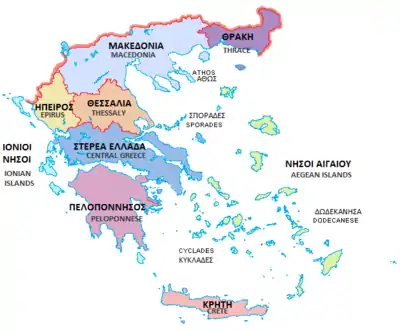Geographic regions of Greece
The traditional geographic regions of Greece (Greek: γεωγραφικά διαμερίσματα, lit. 'geographic departments') are the country's main historical-geographic regions, and were also official administrative regional subdivisions of Greece until the 1987 administrative reform.[1] Despite their replacement as first-level administrative units by only partly identical administrative regions (Greek: περιφέρειες), the nine traditional geographic regions—six on the mainland and three island groups—are still widely referred to in unofficial contexts and in daily discourse.
| This article is part of a series on |
| Politics of Greece |
|---|
 |
As of 2011, the official administrative divisions of Greece consist of 13 regions (Greek: περιφέρειες)—nine on the mainland and four island groups—which are further subdivided into 74 regional units and 325 municipalities. Formerly, there were also 54 prefectures or prefectural-level administrations.
| Geographic region | Post-1987 administrative region(s) | Map |
|---|---|---|
| Aegean Islands | split into North Aegean, South Aegean |  Map showing Regions of Greece |
| Central Greece | split into Attica, Central Greece, part of Western Greece | |
| Crete | identical | |
| Epirus | identical | |
| Ionian Islands | identical, apart from Kythira, which became part of Attica | |
| Macedonia[2] | split into Western Macedonia, Central Macedonia, part of East Macedonia and Thrace | |
| Peloponnese | split into Peloponnese, part of Western Greece | |
| Thessaly | identical | |
| Thrace | merged into East Macedonia and Thrace |
See also
Notes
- Π.Δ. 51/87 "Καθορισμός των Περιφερειών της Χώρας για το σχεδιασμό κ.λ.π. της Περιφερειακής Ανάπτυξης" (Determination of the Regions of the Country for the planning etc. of regional development, ΦΕΚ A 26/06.03.1987
- In Macedonia there is one autonomous region, Mount Athos (Ayion Oros, or "Holy Mountain"), a monastic state under Greek sovereignty. It is located on the easternmost of the three large peninsulas jutting into the Aegean from the Macedonian mainland.